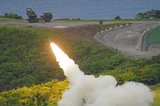US suspends military drills with South Korea
The decision to delay joint military exercises with South Korea until after the Winter Olympics was made for practical reasons, rather than as a political gesture, the US DoD announced on 4 January.
The DoD said the Olympics are South Korea's biggest event in terms of international tourism.
Jim Mattis, US defence secretary, said: ‘For us, it is a practical matter. We have at times changed the timelines on these (drills) for any number of reasons, so for us, this is the normal give and take that we have.’
After a year that has seen tensions on the Korean peninsula spike to their worst levels in years, 2018 has begun on a tentatively warmer note with Seoul responding positively to North Korean leader Kim Jong-Un's New Year speech.
On Wednesday, the two countries restored a cross-border hotline that had been shut down since 2016. They have also agreed to hold high-level talks next week - the first since 2015 which will focus on 'matters of mutual interest,' including the North's participation in the Winter Olympics.
Mattis said the talks were the result of international pressure, pointing to successive UN Security Council votes against the North.
'It shows again that the democracies and the nations that are trying to keep this from going to war and stopping the provocations of nuclear weapon development, of ballistic missile launches and that sort of thing are united in trying to keep this thing in a diplomatic-solution vein,' he said.
The Pentagon chief declined to address a recent tweet from US president Donald Trump, who said Washington had a nuclear button that was 'much bigger and more powerful' than North Korean leader Kim Jong-Un's.
'My job as the secretary of defence is to make certain that we have forces ready to defend this country,' Mattis commented.
The drills are expected to be conducted sometime after the Paralympics, which end on 18 March.
More from Defence Notes
-
![How might European countries look to tackle drone incursions?]()
How might European countries look to tackle drone incursions?
Disruption of infrastructure in Europe, whether by cyberattack, physical damage to pipelines or uncrewed aerial vehicles flying over major airports, as has happened more recently, is on the rise. What is the most effective way of countering the aerial aspect of this not-so-open warfare?
-
![Taiwan approved for $11 billion weapon purchase from US]()
Taiwan approved for $11 billion weapon purchase from US
The US State Department’s approval of a multi-billion-dollar sale of weapons to Taiwan includes tactical mission networks equipment, uncrewed aerial systems, artillery rocket systems and self-propelled howitzers as well as anti-tank guided missiles.
-
![Ireland spells out $2.3 billion shopping list in five-year defence spending plan]()
Ireland spells out $2.3 billion shopping list in five-year defence spending plan
Ireland’s multi-annual investment in capital defence spending is set to rise from €300m in 2026 to €360m in 2029–2030 with major upgrades across land, air, maritime and cyber domains.
-
![Canada to deepen integration of multi-domain capabilities to strengthen its defences]()
Canada to deepen integration of multi-domain capabilities to strengthen its defences
The Canadian Department of National Defence has created new organisations to manage the procurement and integration of all-domain solutions and allocated US$258.33 million to strengthen production capacities.
-
![US National Security Strategy prioritises advanced military capabilities and national industry]()
US National Security Strategy prioritises advanced military capabilities and national industry
The 2025 NSS has emphasised investment in the US nuclear and air defence inventory and national industry, but it leaves multiple unanswered questions on how the White House will implement this approach.
-
![Canada set to look away from its neighbour and across the Atlantic for partners]()
Canada set to look away from its neighbour and across the Atlantic for partners
While non-EU UK struggles to join the Security Action for Europe initiative, which provides loans for defence programmes, Canada has become the first country outside Europe to get access – and did so for a nominal fee.
























